How do odour-killing insoles stamp on smelly feet? Do submariners' ears pop? How do Portuguese Man o'War jellyfish reproduce? We take on your science questions this week as well as hearing the highlights from the Cambridge Science Festival and making a tornado from flames. Plus, news of octopuses having high definition temper tantrums, why some people are genetically wired to feel more pain, eyeless scorpions that have evolved their way out of a blind alley and how scientists can see what's going in your mind's eye...!
In this episode
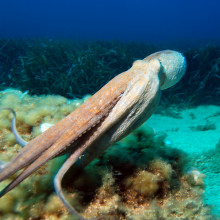
01:37 - Octopus mood swings revealed in high definition
Octopus mood swings revealed in high definition
Pushing a high definition TV screen up to the side of an octopus's aquarium tank and showing them images of crabs and other octopuses, scientists have revealed these intelligent marine creatures can undergo major mood swings ranging from glum to excitable and aggressive.
Previous attempts to show moving pictures to octopuses have failed, probably because the old style cathode ray TV screens only show pictures 26 times a second, which isn't fast enough for their sophisticated eyes so the images were probably unrealistic and incomprehensible to them.
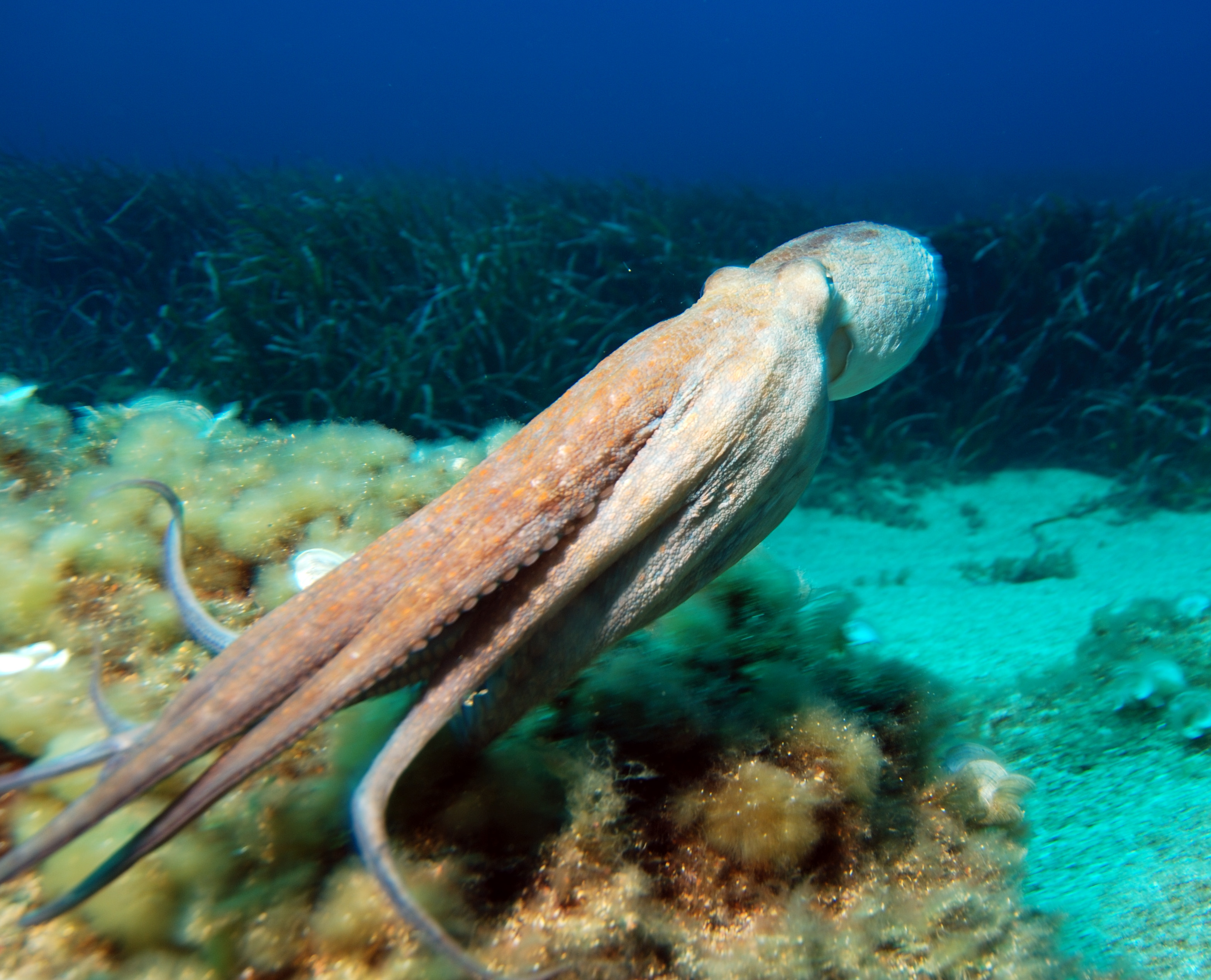 Renata Pronk and colleagues from Macquarie University, Australia decided to try octopuses on the new generation of liquid crystal high definition TV screens and with a bit of trial and error they discovered that octopuses do respond to image shown at a rate of 50 frames a second.
Renata Pronk and colleagues from Macquarie University, Australia decided to try octopuses on the new generation of liquid crystal high definition TV screens and with a bit of trial and error they discovered that octopuses do respond to image shown at a rate of 50 frames a second.
They were working a species that lives in Sydney harbour called, Octopus tetricus, and known as the Gloomy Octopus. The team knew the octopuses could see the HD images when they rushed up and tried to attack pictures of a crab - their favourite food.Show them film of another octopus and they dash to the back of the aquarium and try and hide.
Publishing in the Journal of Experimental Biology, the team repeated their tests over the course of several weeks and uncovered the octopuses' mood swings.
In the same day, an individual octopus reacted in a consistent way to film of a crab or another octopus. But later the same week, their behaviour was often very different. Some animals were initially quite excitable, but on another occasion were gloomy and much less enthusiastic.
The team also tested the octopuses' curiosity, showing them film of a jar they hadn't seen before. Some days they weren't bothered by it, and other days they would be curious and go take a look.
While it seems that octopus may have personalities, they aren't especially consistent over time. Get them on a bad day and an octopus can be very grumpy, but try again tomorrow and you might find a very different animal indeed.
Now that Pronk and the team have worked out how to play octopus movies they are keen to find out more about these extraordinary, intelligent animals including how they communicate with each other.

05:20 - Pain perception under genetic influence
Pain perception under genetic influence
Cambridge researchers have identified gene sequences that make some people feel more pain.
Molecular biologist Geoff Woods, together with colleagues internationally,  made the discovery when he compared the pain scores reported by 578 arthritis patients with the severity of their disease as revealed as revealed by X-rays of their joints.
made the discovery when he compared the pain scores reported by 578 arthritis patients with the severity of their disease as revealed as revealed by X-rays of their joints.
Some patients, the team found, were reporting more pain than others, despite having arthritis of similar severity.
To find out why the researchers then matched up the patients' pain scores with the DNA sequences they carried for a gene called SCN9A, which is known to be active in pain-conveying nerve fibres.
This led the team to identify two variants of the gene in the patients, a rarer "A" form and a more common "G" form. On average, patients carrying the A variant tended to report more severe pain than patients carrying the G form of the gene, despite having arthritis of similar severity.
To confirm the findings, the researchers then repeated the study on 179 patients with lumbar back pain, with similar results, and also subjected a group of female volunteers to a range of painful stimuli, again demonstrating that individuals carrying the A form of the gene were more pain-sensitive.
To find out why, the researchers expressed the SCN9A gene in cultured HEK293 cells, which have nerve-like properties. The gene encodes part of an ion channel, which sits on the membrane and allows sodium to enter the cell, altering its electrical activity.
In these cells, the team found, the A and G forms of the gene had subtly different electrical properties, sufficient to explain the increased sensitivity of carriers of the A form to painful stimuli.
This shows, say the researchers in their paper in PNAS, that human pain perception is under genetic influence; understanding how to modify the functions of these pain-specific genes will inevitably lead to improved analgesics and the identification of individuals with more specific pain-killing requirements.
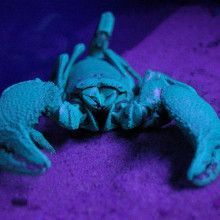
08:43 - Eyeless scorpion isn't stuck down a blind alley
Eyeless scorpion isn't stuck down a blind alley
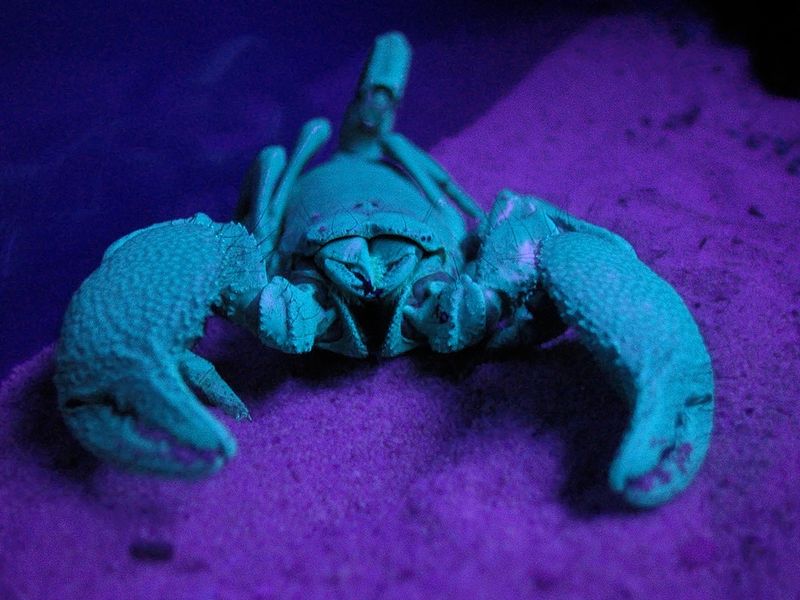 Eyeless scorpions living in deep inside caves in Mexico have returned to light and regained the ability to see, showing that a specialized way of life is not always an evolutionary blind alley.
Eyeless scorpions living in deep inside caves in Mexico have returned to light and regained the ability to see, showing that a specialized way of life is not always an evolutionary blind alley.
Lorenzo Prendini from the American Museum of Natural History in New York, leads a team who have been studying a group of closely related scorpions, many of which have lost their eyes and become pale and unpigmented - both adaptations to life in dark, sunless caves.
Prendini and the team scrutinised nearly 200 physical characteristics of the scorpions to work out how closely related individual species are, including mapping the arrangement of tiny hairs on their pedipalps (the scorpions' large pincers). They then used this data to build a family tree, which revealed that the generalist species living closer to the surface, under stones and leaf litter, have evolved independently more than once from cave-dwelling ancestors.
Until now, it has been widely assumed that when species evolve specialist characters for a particular environment - such as blindness in caves - they cannot reverse that and become less specialised again. Now the scorpions are showing us that they can.
Scorpions first evolved around 450 million years ago and today there are thought to be around 2000 species in the world, but only 23 of them are known to live in the permanent dark deep inside caves - so-called troglobites. The deepest one lives 1km below the surface.
Many of the surface-dwelling scorpions in this area of Mexico were wiped out around 65 million years ago, perhaps by the nearby meteorite impact that some think killed off the dinosaurs.
But we now know that when scorpions evolved to live in caves, they didn't necessarily condemn future generations to remain stuck in the dark, and that loosing eyesight is not an evolutionary dead end.

11:20 - Reading Thoughts with a Brain Scanner
Reading Thoughts with a Brain Scanner
with Dr Demis Hassabis, University College London
Chris - Also in the new this week, researchers at University College London have developed a way to read a person's thoughts and basically see what they're seeing in their mind's eye using a brain scanner. Dr. Demis Hassabis is behind this study and he's with us now. Hello, Demis.
Demis - Hello.
Chris - Welcome to the Naked Scientists. Tell us, if you would first of all, what it is you actually have discovered.
Demis - What we did in the study was to basically get volunteers to view three  short video clips. These are video clips of every day common events like someone posting a letter or someone throwing a piece of trash in a bin. Then what we did was to ask them to memorise those video clips in as much detail as possible, and then a short while later they were placed in the scanner and they were asked to freely recall those three memories in any order they wanted to, and as many times as they wanted to. After the scanning, we analysed their brain scans and we found we were able to tell which one of the three memories they were recalling and at which time, at an above chance level.
short video clips. These are video clips of every day common events like someone posting a letter or someone throwing a piece of trash in a bin. Then what we did was to ask them to memorise those video clips in as much detail as possible, and then a short while later they were placed in the scanner and they were asked to freely recall those three memories in any order they wanted to, and as many times as they wanted to. After the scanning, we analysed their brain scans and we found we were able to tell which one of the three memories they were recalling and at which time, at an above chance level.
Chris - What was the scanner seeing?
Demis - We were focusing on this small region of the brain called the hippocampus that is known to be essential for this kind of memory. We used quite sophisticated machine learning algorithms to try and spot patterns in people's brain scans, and that's what we're able to do here with just the activity patterns in the hippocampus, and we're able to tell from that which memory someone was recalling.
Chris - How is the brain playing out that memory through that brain structure in a way that you're able to eavesdrop on?
Demis - What we think is going on is that when they first see these videos in the training session, the hippocampus is responsible for laying down a memory trace, or a copy of that memory. So that's what allows you to remember something in the future, you basically reactivate that memory trace. So, what we've done here is try and investigate that memory trace directly and come up with a technique that allows us to look at that memory trace directly in vivo in a functioning human brain.
Chris - And how does this inform our understanding of how that part of the brain actually works? Presumably also, how we then extend that into what happens when it goes wrong with aging and dementia and things?
Demis - This study is part of a program of studies that are investigating the fundamental structure of memory. What we'd like to know is things like - what aspects of an experience are preferentially recorded the brain? Obviously, these are important questions because if we can understand how the brain does that, then maybe we can help form therapies for people who have disorders such as Alzheimer's or dementia, where we can try and enhance their memory for the things that they need to remember, over and above other stuff that is not so essential to them.
Chris - And could you extrapolate the study to look into other modalities, other aspects of memory? You just asked people to watch three short films, but could you make it much more detailed? How far do you think you could take this?
Demis - What we're planning to do next, and in the process of doing at the moment, is extending it further into looking at whether, for example, it's the content of a memory or the context, i.e. what happened or where it happened, that actually best defines the memory. That's the start of actually breaking down memories into their components. So we can actually eventually start looking at which features or which aspects of an experience the brain is coding for.
Chris - But of course, it is a little bit artificial because your system had to learn from these people first in order to know what it was looking for and then record back when they did their free imagination and matched the two things together. It's a bit further down the line before presumably you'll be able to put someone in the scanner and then workout what they're thinking about without having pre-learned?
Demis - Yes, that's right. We're long, long away from creating some kind of general purpose, mind reading machine or something. What we did here is that these are predefined memories that we know that the volunteer is going to choose between. Even then we're not 100% accurate. So very much at the moment, it's still fundamental research rather than any kind of application such as that.
Chris - So the HMRC, the Inland Revenue are going to have to wait a little while before they can tell whether people are being absolutely honest with their tax returns in the future.
Demis - That's right. That's right.
Chris - Demis, thank you very much.
Demis - Thank you.
Chris - That's Dr. Demis Hassabis. He is at University College London. If you'd like to read a bit more about the paper he was discussing that he and his colleagues have published is in the journal Current Biology this week.
Do submariners ears pop?
Helen - No their ears probably don't pop because in fact, unlike a scuba diver who takes down a tank of air and breathes it at pressure that is equal to the water around them-which becomes very high very quickly as you go down-submarines are pressurised so that inside them they maintain the same pressure as air at the sea surface (1 atmosphere or atm: the unit we use to measure pressure). Whereas when you're scuba diving, you could be breathing air at something more like 20 atmospheres, which is much more dense. It's that pressure that makes your ears pop and you haven't got that in submarines. You may get a bit of compression as you're going down in a submarine as some of that pressure from the water is pushing in on the metal structure and the air inside. But I think that's fairly minor, I imagine. They build submarines fairly tough so that they can withstand all this pressure without collapsing inwards. So no, submariners don't have popping ears and interestingly and importantly, it means that if you have an accident, deep down and you have to escape from a submarine, you won't get the bends because you haven't been breathing air at pressure. You haven't filled up your system with nitrogen which will then bubble out of your blood if you're scuba diving and you come up too quickly. Same thing doesn't happen in the submariners. Submariners are trained to be able to hold their breath for long enough to swim a long, long way up from the bottom of the seabed to the surface and survive if there's a problem down below.
What would happen if we were to try to transplant a piece of brain from one person into another?
Chris - Well actually, scientists have done this in a number of ways. In one instance, there was a complete head transplant done on a chimpanzee where the brain and head from one animal was grafted onto the blood vessels of another, recipient, body.
Now that's all well and good in the sense that it keeps the brain alive because the blood supply is preserved, but what it does involve is severing the connection between the brain and the spinal cord, which is how all the information gets into and out of the brain pretty much.
That means that the animal is destined to have no mobility and no ability to feel incoming information from the rest of its body. So, scientists, if they were going to do head transplants would have to surmount that one.
But, there are limited neuronal grafting and transplant studies being done because there are some neurological diseases, specifically neurodegenerative diseases, which are associated with the death or loss of certain subclasses or groups of nerve cells in the brain.
So scientists have reasoned that, if you're losing certain populations of cells in the brain, perhaps what we need to do is to put new cells back into that bit of the brain and perhaps they will wire in and they can do the job that these cells that have been lost used to do.
A good example of this is Parkinson's disease, because we know that one specific group of cells that make the chemical dopamine are lost from the brain in this disease.
Scientists have now done a number of experiments where they take foetal brain tissue - and you need foetal brain tissue because this seems to be critical because the cells seem to have a more robust phenotype - in other words, they seem to survive better - and if you harvest those cells that are destined to become dopamine-producing nerve cells in foetuses and you put those into the brain of an individual with Parkinson's disease, into the part of the brain that is lacking dopamine, in other words, is affected by the disease, the cells seem to have the ability to survive to a limited extent, and also, wire themselves in and produce dopamine to make up for the shortfall.
So, scientists are doing that with Parkinson's disease. They are also looking at the disease, Huntington's disease, which is another neurodegenerative disease but is caused by the loss of a different class of nerve cells. So they're trying similar tricks there.
It's early days, and the results have been mixed, but they do show promise and so we think that there is a good reason to be pursuing this.
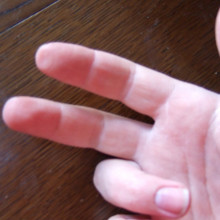
Why do we have finger- and toenails?
Helen - Well, I think some people would answer so they can paint them pretty colours, and that way nails can be part of the way you attract a mate. But in fact, if you look around, lots of different animals that we're related to, lots of other mammals, also have fingernails or claws. And they're all very useful. And we also have them probably because they are useful tools. If you think back to our ancestors when we first evolved as humans, fingernails can be very useful for picking things up - picking the skin off a fruit, say, for scratching an itch.
If you went to see how useful they are, put a sticking plaster or tape over your nails and see how you lose that ability to use your nails as tools. That's probably why we still have them. Why do we have toenails? Probably, because our ancestors, chimpanzee-like creatures, also use their feet for manipulating objects and a toenail helps to give you grip. So really, nails are 20 little tools for us to use in our daily lives and that's why we still have them and indeed, I'm glad we do - it can be very painful without them.
Is it possible to wirelessly charge a battery?
Well yes, it definitely is and people are doing exactly that with things like toothbrushes. You might have seen these toothbrush devices where you plug the toothbrush device into some kind of base station or holder, but there's no obvious electrodes. And what's going on there is it's using a magnetic field to convey the energy from the base station into the handset and then from there, into the battery. So what you do is have a coil in the base station which passes an electric current through it, generating a magnetic field and you pass an alternating current through it so that the magnetic field is changing. You then have in the base of the object you want to charge, another coil which you put into the magnetic field which is created by the base station. That's what's happening when you're docking one into the other. The magnetic coil in the device therefore sees this changing magnetic field which induces an electrical current in the handheld device. That current is then fed into some kind of rectifier, to turn an alternating current into a direct current and it's then used to charge a battery. And that happens with things like toothbrushes, there are certain shavers that work the same way. Doing it over a greater distance would be really, really inefficient because the magnetic field decays as 1/r2 so, inverse square law over distance and therefore the amount of energy you'd have to put into the coil would be huge in order to charge things at a remote distance. So it's useful over small distances, it's not very good over long distances.
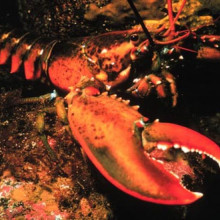
Why are there no lobsters in the Pacific?
Helen - Well, I'm afraid in fact that there are lobsters in the Pacific...
In fact, there are various different species of spiny lobsters which don't have big claws like the American lobster, Homerus americanus, which does have big claws. That's one from the Atlantic.
But there are some spiny lobsters, including the California or red rock lobster, Panulirus interruptus, and there's also one called the green spiny lobster, and they do live on the Pacific, from California, down through into Peru and out into the Pacific as far as the Galapagos Islands. There are various species that do live there.
I assume when you say you like lobsters, you like to eat them, and that's fair enough - they can be quite tasty - but some populations of lobsters around the world are very heavily fished and therefore, there aren't lots of them around for us to carry on eating. And that could well be the case in California for some of these species.
Although, in fact, down in Mexico, in Baja California, there is a fishery for the red rock lobster which, about five years ago, was labelled as sustainable by the Marine Stewardship Council. This means that fishermen down there are keeping within sustainable catch levels so there should still be a healthy population in years to come.
So, if you do want to eat Pacific lobsters, I would definitely send you to Mexico to try out the red rock lobsters down there!

27:50 - The Cambridge Science Festival
The Cambridge Science Festival
with Jim Haseloff, University of Cambridge; Gareth Fabrow, University of Cambridge; Gordron Day, Williams F1, Holly Margerison, MRC
Meera - This week saw the start of the Cambridge Science Festival. So I've come along to one of the main event days which is Science on Saturday. I've kicked things off today by visiting the plant sciences department and with me to tell me more is Jim Haseloff from the plant sciences department here at the University of Cambridge.
Jim - The theme of this year's science festival is diverse science, looking at diversity in development, diversity in physiology, diversity in properties of plants. Within the tent, we've got quite a range of activities and diverse plants, there's a supply of seed and flowers, synthetic biology and application to engineering of plants both now and the future. Essentially, thinking of how living systems work and how you might tweak or adjust them in the same way you might adjust a plant to produce more drug for drug production or to improve production for bio-energy or for food production for example.
Meera - The point of the festival is to make things a bit hands-on and interactive. So, what are the key hands-on activities that you've got here today because I've seen children looking in microscopes and handling mushrooms..?
Jim - They range from just the observation of biological systems or looking at fungi and 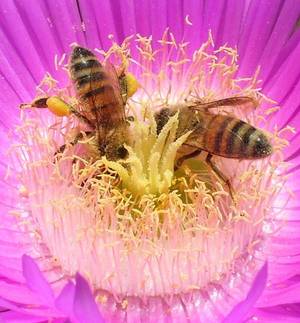 plants and algae through to a giant flower that children can crawl into and that giant flower is full of nectar in the form of sweets, and they have pollen then full of glitter, and the kids dress up in bee suits and crawl into the flower and do the job a bee does essentially.
plants and algae through to a giant flower that children can crawl into and that giant flower is full of nectar in the form of sweets, and they have pollen then full of glitter, and the kids dress up in bee suits and crawl into the flower and do the job a bee does essentially.
Meera - Actually that's just behind us now I think and it's quite popular.
Jim - It's extremely popular. And we've got building your own fantasy seeds, which you can use to build various motifs you see in seeds. We've got interactive reprogramming of floral structures...
Meera - So lots going on?
Jim - Yeah, yes. It's all fun.
--------
Meera - So, I've stepped away from the plants now and I've decided to try and travel back in time by visiting the Time Truck activity here at the festival. With me is Gareth Fabrow who's a student at the Earth Sciences department here at Cambridge. Hello, Gareth.
Gareth - Hello.
Meera - What are the main aims of the Time Truck here today?
Gareth - Mainly, we want to bring out rocks and fossils which are normally kept in museums behind glass, and allow people to actually touch them and interact with them and get a closer look. We have bits of all types of earth science. We've got some fossils, some dinosaur pieces, we have some rocks, minerals, and we also have a volcano. But it's generally to think more about our planet, how it's put together, what it was like in the past, and how we can tell that, more importantly.
Meera - So we're actually standing now by your favourite hands-on activity here today, and it's a very large dinosaur foot!
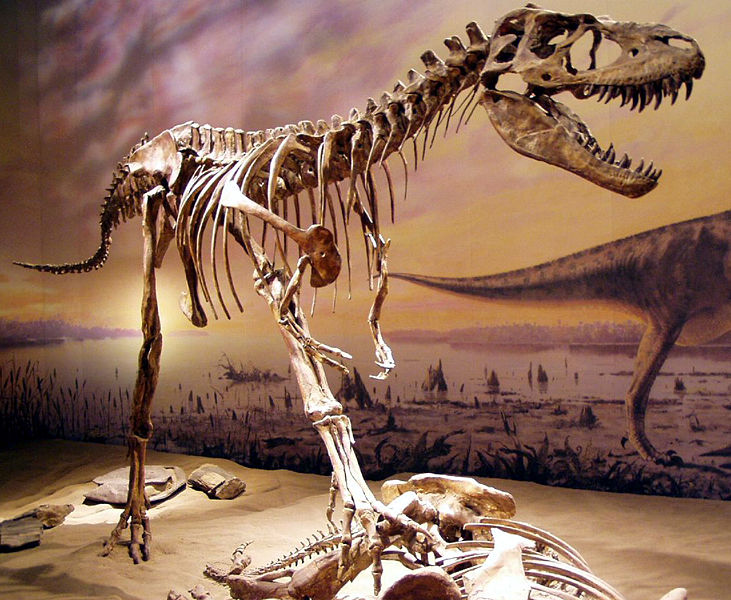 Gareth - Yeah, well this is from an Albertosaurus which is like a T-Rex but a bit smaller. The foot is still about 2 feet long and has sharp claws on the end. I also have here a chicken's foot and if you can compare the two, they both have three toes and they both have the same amount of bones in their toes, and they have similar claws on the end. Obviously, the chicken's foot is a lot smaller. So from that, we can deduce that dinosaurs evolved into birds. Well with that and lots of other bits of evidence as well.
Gareth - Yeah, well this is from an Albertosaurus which is like a T-Rex but a bit smaller. The foot is still about 2 feet long and has sharp claws on the end. I also have here a chicken's foot and if you can compare the two, they both have three toes and they both have the same amount of bones in their toes, and they have similar claws on the end. Obviously, the chicken's foot is a lot smaller. So from that, we can deduce that dinosaurs evolved into birds. Well with that and lots of other bits of evidence as well.
------
Meera - I was just heading over to the pit building but on my way, I just stumbled across a Formula One car in the middle of a car park. So I'm now here with Gordon Day who works with the Williams F1 team.
Gordon - Williams and Cambridge University press have done an educational software package for a primary school called Race to Learn and we're demonstrating one of the modules for Race to Learn here at the festival. We've brought a racing car as well so that we can show everyone coming through our racing car up close.
Meera - So tell me a bit more about this Formula One car because it looks fantastic.
Gordon - This Formula One car is from 2003. It's an FW25 and it was raced by Juan Pablo Montoya and Ralph Schumacher.
Meera - Wow! Tell me a bit of the actual stats of the car.
Gordon - It has a BMW engine. It can go up to 250 miles an hour easily...
Meera - Where the driver sits, it's just in front and there's lots of different coloured buttons. So these obviously control very crucial aspects of the car.
Gordon - That's right. It looks a bit like the cockpit on a fighter plane with lots of  controls for the driver and they control the various systems on the car, plus you can push a radio button to talk to the pit and there's even a drinks button that delivers a drink to him through his helmet.
controls for the driver and they control the various systems on the car, plus you can push a radio button to talk to the pit and there's even a drinks button that delivers a drink to him through his helmet.
Meera - Very clever. So lots of technology involved here?
Gordon - A lot of technology indeed.
Meera - How would you say the visitors have been reacting to the car then? I mean, I'm just quite surprised to see it here.
Gordon - Well, I've been answering lots of questions all day so far. I think they really enjoy seeing a Formula One car up close. A lot of the detail, the aerodynamic detail is not easily seen on the television and people have commented that coming up close and seeing that is quite something, quite amazing...
Thomas - Hello. My name is Thomas Abbott and I am standing next to a Formula One car.
Meera - Have you learned anything about it that you maybe didn't know before. Is there anything that you learned about it that's quite surprising?
Thomas - That their pit stops are around three seconds now. It's like it stopped then bzzz... and all the tires are off and they got a board underneath. So if it goes too low, then quite a lot of the board will be scraped, so they know they have to make it higher.
Meera - Has this made you want to be a Formula One driver?
Thomas - I've always wanted to be a Formula One driver.
----
Meera - It's been a long day here at the festival and I have to admit, I'm very hungry. So I found out about a food factory that's going on at the Pitt building. From what I can see, there are children everywhere, making lots of bags of cereal. And here to tell me more about how they're making these is Holly Magerison who's from the Human Nutrition unit at the Medical Research Council here in Cambridge. Hello, (Hollie).
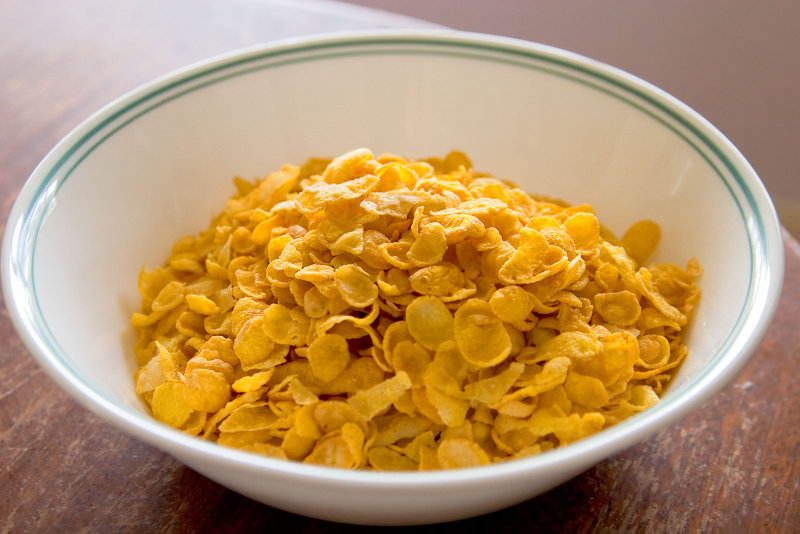 Hollie:: Hi, there. We're basically trying to show children what actually goes into the food that they're eating. So, a lot of children will go into a supermarket, pick up a cereal box from the supermarket shelf, take it home and eat it, but not really know what's actually going into it. We're showing them the malt extract, the added salt and sugar for flavouring that goes into the cereal, we're also showing them the iron and the six different B vitamins that are going into their corn flakes. Not only that. We're also showing them that not all food processing is bad. And that making cornflakes takes quite a long time as they're finding today. The children are removing the bran and germ from the corn, they're adding different vitamins and minerals to the corn, they're drying them, they're rolling them out, they're toasting them and we've even got our own tasting panel so they can try different mix and brands of cornflakes to see which ones they prefer.
Hollie:: Hi, there. We're basically trying to show children what actually goes into the food that they're eating. So, a lot of children will go into a supermarket, pick up a cereal box from the supermarket shelf, take it home and eat it, but not really know what's actually going into it. We're showing them the malt extract, the added salt and sugar for flavouring that goes into the cereal, we're also showing them the iron and the six different B vitamins that are going into their corn flakes. Not only that. We're also showing them that not all food processing is bad. And that making cornflakes takes quite a long time as they're finding today. The children are removing the bran and germ from the corn, they're adding different vitamins and minerals to the corn, they're drying them, they're rolling them out, they're toasting them and we've even got our own tasting panel so they can try different mix and brands of cornflakes to see which ones they prefer.
Meera - I can hear a hair dryer going in the background and a lot of pounding. So I'm assuming the pounding is to combine it all together and the hair drying is another way of toasting them.
Hollie - No. we're actually toasting them in the oven. The cooking and drying stage that they do in the industry, they do in huge steam dryers. Obviously, we're trying to bring it down to the Blue Peter level if you like. So we're using hair dryers, just to dry the corn off and then they use the rolling pins to roll out the corn, but as you can hear, the corn can be very tough to roll so they're banging the corn first and then giving it a roll to make it into a flake.
Meera - Which child here do you think I can convince to give me their cereal? Because I'm very hungry...
Hollie - I think they're all very priced possessions. You might be hard pushed to get one yourself.
Meera - Okay, well I can hope! What's your names?
Carl - Carl.
Robert - I'm Robert.
Meera - First of all Carl, what have you learned today about just what goes into your cereal?
Carl - I've learned how they extract the vitamins then they put them back in, and I found that quite intriguing.
Meera - And why did they extract it and just put them back again?
Carl - They extract them because then it makes the cooking process much more easier.
Meera - And how about you Robert? What have you learned about the cereal production process today?
Robert - Well I learned there are lots of different makes of cereals, with different taste and different amount of vitamins in which was actually quite surprising because not all cornflakes tastes the same.
Meera - So have you got your cereal with you now or you're waiting for it to be tasted? What stage are you at?
Robert - I'm waiting for it to be baked at the moment.
Meera - And what about you Carl?
Carl - I'm also waiting for it to be baked.
Meera - Can I tempt you to give me any of your cereal? I'm very hungry.
Carl - Yes.
Robert - Okay then.
Meera - Jackpot! So I'm going to be here now, waiting to give me some of their toasted cereal. But otherwise, that's it for me at the festival...
Why are astronomical objects usually spherical?
Chris - It's a very good question and there's obviously some important science there for the simple reason that it doesn't matter what you look at, most of these objects are round, absolutely. The simple answer is it's down to gravity. If we take our own solar system as a really good example, you have the Sun in the centre and that's round, and the reason that's round is because a big ball of gas collapsed in on itself and squeezed hard enough to start fusion. Around that ball of gas would've been initially an envelope - like a shroud - of material comprising dust, debris and gas, which slowly condensed into a disk called a proto-planetary disk. Over time, all of this material, thanks to gravity - which is a function of mass - would've pulled this material slowly together. It would have accreted - or got together - and slowly would've built up planetessimals, miniature planets, and then they grew to make big planets as they hoovered up - under increasingly powerful gravitational fields - the rest of that residual material.Because gravity is pulling things together, everything that's being attracted wants to get us close to everything else as it can. The most effective way for that to happen is if objects are spherical. It's the same as a raindrop, because water wants to get us close to other water molecules as it can without being in contact with too much air. That's why raindrops form round blobs, not a flat sheet of water - this way, as many water molecules can get as close together and stick together as they can. That's also what's happening with these nascent planets, or other objects in space. The material squeezes together, and the way in which you can get as much material in as close a configuration as possible to other material is if it's a round shape.Now, if you go in at high resolution and look closely, obviously, there's not a perfect round surface because the Earth has mountains and things and so does Mars - it's got Olympus Mons, a giant volcano. But, to all intents and purposes, at low resolution, these things are round because gravity has made them that way.

How resilient are the oceans to over-fishing?
Helen Scales answered this question...
Helen - It's a great question and it's something that's being talked about more and more in the news as we hear about the emptying oceans and fish stocks being depleted.
In fact, I had a look at this question and our listener comes up with a nice idea, in fact a brilliant idea of "couldn't we just give the oceans a rest? If we perhaps blocked off bits of the ocean from fishing for say, 10 years or so, we could rotate around and the oceans would replenish themselves. Could they?"
The answer is "yes, they could indeed". In fact, what you're talking about are marine protected areas or marine reserves this is the sort of tool for ocean management that's being talked about by governments and by conservation groups. Because we know that if you leave a piece of sea alone from the impacts of us people catching so many fish, it will very quickly recover. It's extraordinary how resilient the oceans can be and it does offer us some hope.
The question is, can we actually get this done? I love the idea of blocking off and rotating parts of the ocean that we can have as these protected areas, if only it could happen.
At the moment, less than 1% of the oceans are protected from human activities and there are various estimates as to how much we should protect in order to have a resilient ocean that keeps itself going: that's up to as much as 30% or a third of the oceans.
If we could do that, then we would have much better chance of ensuring that fish stocks and all sorts of other marine creatures will still be around in years to come. So, let's hope we can do that and we can achieve resilience in the ocean because I think it will fight back but we need to give it a helping hand.

41:48 - How far away is the Sun from the moon?
How far away is the Sun from the moon?
Chris - The Moon is pretty close. It's about a quarter of a million miles to the moon and it's about 100 million miles to the Sun, give or take.
But, it's important to remember that the Moon orbits the Earth, taking about a month to complete each lap. That means that the lunar-solar (Moon-Sun) distance varies according to the Moon's orbital position.
So, when the Moon is on one side of the Earth, closest to the Sun, it's about 99 and 3 quarter million miles between the Moon and the Sun.
When the Moon's around the other side, so the Earth is between the Sun and the Moon, then it's about one hundred million plus about a quarter of a million miles, so a hundred and a quarter million miles between the Sun and the Moon!
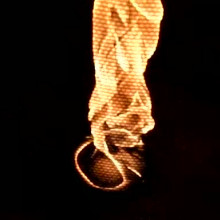
Flame Tornado - A Spinning Column of Fire
Why does hot water sound different to cold water when poured?
Chris - If you've noticed, when you turn the shower on the morning, the cold water comes through from the pipe first and it will splash and sound different against the bottom of the shower compared with when the hot water, which comes along shortly afterwards, comes in; the note will change. This is a real observation; your ears aren't deceiving you.The reason for it is that water changes its viscosity - its stickiness - according to its temperature. If you could zoom in with a really powerful microscope and look at some water molecules, what you'd see is they are shaped like miniature boomerangs. At the apex of the boomerang you would see an oxygen atom and on each of the arms, you'd see hydrogen atoms. Oxygen loves electrons, so it pulls the electrons of itself and the hydrogen towards itself very tightly, and that makes the oxygen a bit minus. The hydrogens are correspondingly therefore a bit plus. As a result, when water molecules are sitting together side by side in solution, the positively charged hydrogens are attracted to the negatively charged oxygens of an adjacent molecule and this is called hydrogen bonding. It makes water sticky, and it gives it some of its special properties that in fact help it to make life happen on Earth. So it's pretty important that this happens. But, when you heat the water up, the particles start to move much more quickly. They have more kinetic energy which is a function of the temperature. This means that they're zipping past each other much faster. They're therefore gluing onto each other less well and this makes the water runnier or less viscous. So when it comes splashing out of the shower and hits the shower pan, the water fragments into smaller particles and makes a higher pitched splashing noise than when it goes into the cup or goes into the sink when it's cold. Have a listen next time you're in the bath for the shower and you will see that the note is different.

How does my paint change colour as it dries?
Chris - Now that's a fantastic question.
It's the same science behind why clothes look a bit darker when they're wet than when they're dry.
The reason that this happens is because when you have paint in the tin, the paint is mixed with some kind of solvent - usually water or oil or something, which makes the paint easy to spread onto the surface so you get a nice even coat.
When you paint the paint onto the wall, it's got all that solvent in it. The solvent then evaporates off - dries - and this leaves behind just the particles of paint on the wall.
Now, the particles, if we take white paint as an example, are usually titanium oxide; they're very, very white. These particles are roughly the same size as the wavelength of light, which is why they reflect and scatter lots and lots of wavelengths of light back at you, which is why you see a white surface.
But, when the paint is wet, those particles are surrounded by little droplets of water or oil (the solvent). And so, when light goes in, it doesn't see these tiny particles of roughly the same size as the light wavelength.
Instead it gets subjected to a bit of refraction through the fluid and that buries it deeper into the wall surface, rather than reflecting it back out at you.
So, if it's darker of course, what must be happening is less light is being scattered back towards you than being absorbed and that's why it looks darker.
Once that effect goes away (when the solvent evaporates) and you've just got the particles there, you're scattering more light back at you, so the paint looks brighter.
How do odour-abating insoles work?
Chris - Most of them have got activated charcoal in them. All that means is that it's charcoal with a big surface area, and this means you've got carbon, which can soak up noxious odours. So you have something that can lock away odours, that's the first point, and it will also do another thing, which is soak up water.Your feet squirt into your socks something like a quarter to half a litre of sweat every day. At the same time, you've got skin cells falling off at the rate of thousands every second from all parts of your body, but your feet especially because the skin on your feet is a bit thicker. So what you've got are all of the elements of the perfect microbiological or bacterial banquet going on on your feet: you've got food in the form of dead cells, you've got water in the form of sweat, and you have warmth. All these things add together to very active, hungry bacteria being well fed. Consequently, they produce various chemicals, some of which are whiffy - smelly; they're volatiles. But if you put these odour eating things into your shoes, they soak up the water for a start, which means that there's less to keep the bacteria lubricated so they don't grow as well, and they also soak up some of the noxious gases because they have a big surface area and they can adsorb those materials, which prevents them from being so pungent. So they work in a number of ways, but that's chiefly how it does it.
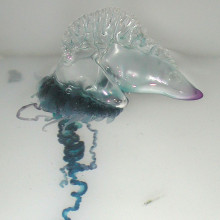
How do Portuguese-man-o-war jellyfish reproduce?
We put this question to marine biologist Helen Scales...
Helen - Wonderful creatures indeed! Although keep your distance, of course, because they are nasty stingers, but they're beautiful things to look at.
I think this question is based on the fact that our listener knows that these animals are in fact not jellyfish.
They're not single living creatures like that but they're colonies of lots of little creatures that live together.
They belong in the same phylum, the Cnideria, as jellyfish and they look similar but they are in fact different organisms.
Portuguese man-o-wars are called "siphonophores" and they're made up of three main different types of little animals that live together.
There are dactylozoids, which make up the tentacles; there are gastrozoids, which are the bits that eat the food; and there are gonozoids, which are the bits of these creatures that reproduce. They produce sperm and eggs. In fact, you get female and male Portuguese man-o-war, even though they're called "Men"!
The sperm will fertilise eggs in the water column to produce larvae, which grow into bigger Portuguese man-o-wars.
The way that they grow from those individual cells is by asexual division of those cells and they produce all those individual three types of animals that live in this one colony and drift around the oceans, stinging things and eating things as they go.

55:47 - Do subliminal CDs work?
Do subliminal CDs work?
We put this to Ian McLaren, Professor of Cognitive Psychology at the University of Exeter.
Ian - The answer to this question is no, but with a hint of yes to it. I'll start with the bad news: These CDs are unlikely to be an easy way to acquire new knowledge such as a new language for example, before considering evidence to subliminal learning itself, subliminal learning means learning that takes place below the normal threshold for awareness. An example would be learning a list of words by listening to them while you were asleep. If you were able to recall the words afterwards when you are awake, then that would be evidence for subliminal learning. The problem with demonstrations of this kind, and there have been some, is that there is often insufficient control to ensure that the listener is really asleep. When these studies are done well using EEG monitoring to ensure that the subject is genuinely asleep, the results tend to be unimpressive. There is little evidence of above chance recall of the words. So in this sense, these CDs are unlikely to work. There is however some evidence for a different kind of learning under subliminal conditions. Even though the listener cannot recall the words, we can show that they've had a detectable impact on them. We use a different test in which I'll ask you to say the first word that comes into your mind and I'll give you a cue word. Imagine a list you'd been exposed to contains the word "Traffic." If I now cue you with the word jam, you'll be quite likely to offer traffic as a response. But if the list had instead contained the word "strawberry," then that would be the more likely response to my cue. This in fact does seem to occur on the subliminal presentation of words. Psychologists see it as an example of priming where experience with a word makes it more accessible, more readily available in some way. But this is not new learning. It's better thought of as modulation of memories that you already have. So I'm afraid this "yes" part of my answer is not likely to be terribly useful to you when it comes to acquiring new information.










Comments
Add a comment